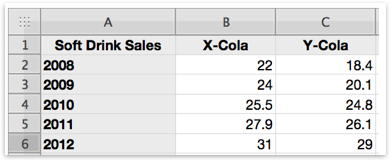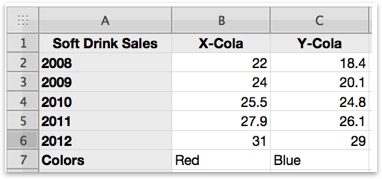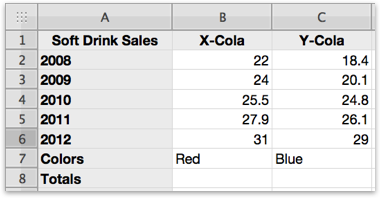Introduction
You can specify your data in one of two formats: CSV or JSON. If you’re new to this, CSV format is probably the place to start.
CSV Format
The easiest way to create a CSV file is to use spreadsheet software like Excel or Numbers. Creating the data is as simple as entering a table like this:

This creates a graph like this:

In order to see this graph in Status Board, you need to 1) save your table data to CSV format, and 2) make your CSV file accessible on the network.
Saving to CSV Format
- In Numbers: Choose File > Export… and choose CSV.
Delimiters in CSV files can be either commas or semicolons. Please do not use grouping separators in any numeric values (for example, expressing the number one thousand as “1,000” or “1.000”.) Grouping separators will cause your values to be parsed incorrectly.
Adding a graph to your status board
Go into Edit Mode by tapping the “gear” icon in the upper left of your iPad’s screen, then tap “Edit”. Drag a graph panel onto your board (pictured below), placing and sizing it however you’d like.
Making your data accessible to Status Board
Now that your table data is in a file, you need to put that file in a location where Status Board can access it. There are two ways to do this:
1. Storing your file on Dropbox
This is the simplest method, especially if you’re already a Dropbox user.
- You’ll need the Dropbox application installed on your iOS device.
- While in Edit Mode, tap on your Graph panel to display the panel’s customizer.
- Tap Dropbox.
- The Dropbox app will open; grant Status Board permission to access your Dropbox. (Status Board will only access the file you specify, and will not access any other file on your Dropbox.)
- After you grant access, Status Board will re-open. Browse through your Dropbox folder hierarchy and find the file that contains your graph data. Tap on that filename.
You’re done! Status Board should display your graph. When changes are made to the file on your Dropbox, those changes should be reflected on your status board within a few minutes.
2. Storing your file on a web server
This method requires that you know how to place a file on a web server.
- Store your file on a web server of your choosing.
- While in Edit Mode, tap on your Graph panel to display the panel’s customizer.
- Tap URL.
- Enter the URL of your file.
- Tap Save.
You’re done! Status Board should now display your graph. When changes are made to the file on your web server, those changes should be reflected on your status board within a few minutes.
CSV Tips & Tricks
If you want to specify custom colors for your graph, just add a row called Colors. The color values can be red, blue, green, yellow, orange, purple, aqua, or pink.

If you want to see totaled values on your graph, just add another row called Totals. (No need to put any totaled values in your table; Status Board will calculate them for you.)

JSON Format
If you’re creating the graph data yourself, CSV is probably simpler. If you have software that will be creating the graph data for you?or you need more sophisticated graphing capabilities?JSON is probably a better choice. The JSON format looks like this:
{
"graph" : {
"title" : "Soft Drink Sales",
"datasequences" : [
{
"title" : "X-Cola",
"datapoints" : [
{ "title" : "2008", "value" : 22 },
{ "title" : "2009", "value" : 24 },
{ "title" : "2010", "value" : 25.5 },
{ "title" : "2011", "value" : 27.9 },
{ "title" : "2012", "value" : 31 },
]
},
{
"title" : "Y-Cola",
"datapoints" : [
{ "title" : "2008", "value" : 18.4 },
{ "title" : "2009", "value" : 20.1 },
{ "title" : "2010", "value" : 24.8 },
{ "title" : "2011", "value" : 26.1 },
{ "title" : "2012", "value" : 29 },
]
}
]
}
}
JSON Tips & Tricks
Refresh Interval
You can specify how often you’d like Status Board to poll your graph data:
{
"graph" : {
"title" : "Soft Drink Sales",
"refreshEveryNSeconds" : 120,
"datasequences" : [
{
"title" : "X-Cola",
"datapoints" : [
...
This parameter is optional. If you leave it out, it will use the default interval of 120 seconds. (This may change in future builds of Status Board.) The minimum value is 15.
Color
Add "color" to a datasequence object:
{
"title" : "X-Cola",
"color" : "red",
"datapoints" : [
{ "title" : "2008", "value" : 22 },
{ "title" : "2009", "value" : 24 },
{ "title" : "2010", "value" : 25.5 },
{ "title" : "2011", "value" : 27.9 },
{ "title" : "2012", "value" : 31 },
]
}
Color values can be yellow, green, red, purple, blue, mediumGray, pink, aqua, orange, or lightGray.
Totals
Display totals by adding an attribute to the graph object:
{
"graph" : {
"title" : "Soft Drink Sales",
"total" : true,
"datasequences" : [
...
Graph Type
Status Board can draw line or bar graphs, and tries to make the best choice for your data. If you want to force Status Board to go one way or the other, do:
{
"graph" : {
"title" : "Soft Drink Sales",
"total" : true,
"type" : "bar",
"datasequences" : [
...
Graph type values can be bar or line.
Scaling the Y-axis
If you want the graph’s Y-axis to start at a particular value and/or end at a particular value, do:
{
"graph" : {
"title" : "Soft Drink Sales",
"yAxis" : {
"minValue" : 50,
"maxValue" : 150
},
...
Either minValue, maxValue, or both values can be specified. (Both together are not required.)
Specifying Units
If you want the graph to display a units string with your values (say, a “$” in front of a number, or a “%” behind), do:
{
"graph" : {
"title" : "Soft Drink Sales",
"yAxis" : {
"units" : {
"prefix" : "$",
"suffix" : "%"
},
...
(Though you probably wouldn’t want to show these two together at the same time.)
Scaling Values
If Status Board detects that your numbers are mostly in the millions, billions, etc., it will scale the numbers so they fit more concisely on the graph. (For example, 4,600,000 might become 4.6.) In turn, “(Millions)” or “(Billions)” will be placed in the graph title.
If you don’t want it to do that, do:
{
"graph" : {
"title" : "Soft Drink Sales",
"yAxis" : {
"scaleTo" : 1
},
...
If you want to scale to thousands or millions, specify 1000 or 1000000. (0 will tell Status Board that it should make its best guess, just as it would if no parameter were provided at all.)
Hide Axis Labels
If you don’t want to show values labels on the Y-axis, do the following:
{
"graph" : {
"title" : "Soft Drink Sales",
"yAxis" : {
"hide" : true
},
...
The same can be done for the X-axis by using an xAxis attribute.
Forcing Every X-Axis Label to Display
Oftentimes, x-axis labels represent a sequence in time. Because of this, Status Board will sometimes drop a few of the x-axis labels so as to give more space to a fewer number of labels. (For instance, say your x-axis labels represent the months in a year. If your graph gets small, Status Board may skip every other month to give more space to each label that remains.)
But sometimes you don’t want that to happen. To make sure every x-axis label is displayed, do the following:
{
"graph" : {
"title" : "Soft Drink Sales",
"xAxis" : {
"showEveryLabel" : true
},
...
Error Reporting
If you want to report an error, include an error object in your graph:
{
"graph" : {
"title" : "Soft Drink Sales",
"error" : {
"message" : "Message displayed on panel customizer"
},
"datasequences" : [
...
Other attributes can be listed in the "graph" object, but if the "error" object is present they will be ignored.
Sharing Graphs via URL
It’s possible to have one of your customers install a graph panel onto a Status Board via a URL on a web page. Use the following format:
panicboard://?url=[%-encoded graph data url]&panel=graph&sourceDisplayName=[your %-encoded company name]
The sourceDisplayName argument is optional.
When the user taps on that link on their iPad, Status Board will launch and ask the user if they’d like to install the graph on their Status Board.
Debugging
Debug your graph by quad-tapping on it (four taps in a row) with your Status Board in “locked” (non-edit) mode. This will bring up a debug window that will let you see the graph data your server is sending to Status Board.
Force a refresh of your graph by triple-tapping on it in “locked” (non-edit) mode. (Triple-tapping forces any panel to refresh, not just table panels. Exception: for list panels, use pull-to-refresh.)